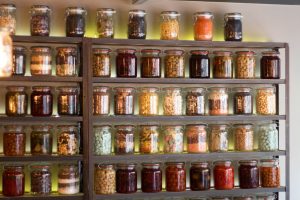In order to understand this post, I have to explain a little bit about what it’s like inside my head. I’m going somewhere with this, I promise. In the world inside my head I tend to do a lot of over thinking of simple concepts–like making mental area graphs to rate meals. I’ve never actually sat down and drawn a graph–that would be crazy!–but I do imagine them on a regular basis.
On these graphs are two axes (axes being the plural form of axis) on which to graph the value of a meal. The x axis is the actual flavor and enjoyment of the meal. The y axis is how much time and effort it took me to prepare it. Graph this point, shade it in, and the area equals the value of the meal.
You didn’t know you were getting an algebra lesson with your blog reading today did you?

In this manner, a meal that might be slightly less exciting to my taste buds, but was really easy to prepare, may end up with the same inherent value of a meal that truly blows me away in the flavor department, but took me 5 hours to pull together.
All you people who zoned out as soon as I mentioned an axis come back to me. I’m done talking about algebra and the inner workings of my brain. But I had to make that point, because my family thought this dish was good, but it wasn’t amazing. However, it still earned a place in my recipe book because it was both good and super easy to prepare. Some days I’m willing to trade some flavor points for some ease in preparation points.
This recipe originally called for all-purpose flour, which I swapped out for my gluten-free flour mix. You can use just about any alternative flour. Mine is a mix of potato starch, tapioca starch, and rice flour which works well for most recipes. If you don’t have diet restrictions, by all means just use the all-purpose flour.
I also used chicken legs and thighs, instead of a variety of chicken pieces, because that’s what was in my freezer. You can use any chicken pieces here. Something with bones in is going to give the most flavor, but I think you’d get good results even with boneless chicken breast or thighs.
After browning the chicken, I chose to deglaze the pan with the wine and then pour all the liquid into the crock pot. As someone with chronic colitis I really have trouble keeping weight on and there was a lot of good fat left behind in the pan, which I needed to keep in the pot and not in the trash. If you, like most normal people, want less fat in your diet, just pour the wine straight into the crock pot when you add the chicken.
After a few hours in the crock pot your chicken will be practically leaping off of the bones, it’s so moist and tender.
I chose to serve this with quinoa, but I actually think rice might have been better. The earthy flavor of the quinoa wasn’t really a good match with the lightly flavored sauce. In any case, you need something to soak up all that yummy sauce. If you’re not gluten-sensitive then the original recipe calls for couscous. Or you could just use some fresh, crusty bread.
Plan to Eat users, click on the recipe title to import directly into your account.
Source: Everyday Food magazine
Ingredients
- 1 whole organic chicken, 3-4 pounds, cut into 6-8 pieces
- salt and pepper
- 1 Tbs oil
- 1 organic onion, halved and thinly sliced
- 6 garlic cloves, halved
- 2 tsp dried thyme
- 1 cup dry white wine
- 1⁄3 cup gluten-free flour mix whatever suits your diet
- fresh parsley for serving
Method
- Season the chicken with salt and pepper. Heat the oil in a large skillet over medium-high heat. In batches, cook the chicken, skin side down, until skin is golden brown, about 4 minutes.
- Combine onion, garlic and thyme in a 5-6 quart slow cooker and season with salt and pepper. Top with chicken, skin side up, in a tight layer. In a small bowl, whisk together wine and flour until smooth and add to slow cooker. Cover and cook on high until chicken is tender, about 3 1/2 hours (or 7 hours on low). Serve chicken and sauce sprinkled with parsley.






